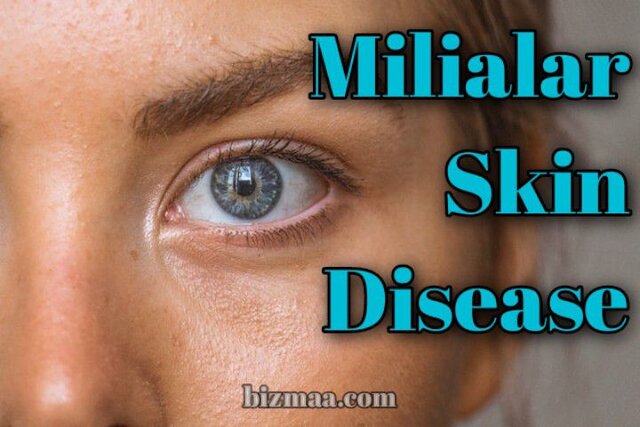Understanding The Causes & Treatment

Table of Contents
Milialar skin disorder influences tens of millions of people globally, and knowing its origins, remedy alternatives, and preventative strategies is essential for those seeking a remedy. Milialar is known as “milia” in medical terminology. It is a common skin disease that causes small, or yellow patches on the skin surface. In this blog post, we’re going to delve into the area of Milialar.
We also find out about the sickness, its reasons, successful remedies, and the way to keep away from it. So, allow’s get started. Keep a watch on all of the causes and remedies of this disorder in this text. Come and benefit. Therefore, examine top to bottom, and get geared up to research something new.
What Is Milialar Skin Disease?
Milialar is often known as “milia” in clinical terminology. It is a commonplace skin situation characterized using tiny, white, or yellowish patches at the pores and skin’s surface. These bumps are maximum usually found around the nose, cheekbones, brow, and chin.
Although milia are painless and innocent, they may be a source of aggravation for those who strive for a smooth, ideal skin.
Milialar Skin Disease: Causes
Understanding the underlying causes of milialar is essential for properly coping with and stopping the illness. However, Milialar Skin Disease can result from numerous factors. These are:
1. Excessive Dead Skin Cells: The collection of dead pores and skin cells on the skin’s floor is one of the important causes of milia. This deposit can block pores and reason milia to appear.
2. Sweat & Oil: Excessive sweating and immoderate oil manufacturing may foster the improvement of milia. These variables can block dead skin cells, resulting in the formation of milia.
3. Wrong Skincare Products: Using heavy or comedogenic skincare products might clog pores and accelerate the development of milia.
4. Sun Damage: Prolonged sun exposure can cause pores and skin damage, making it a chance for milia disorder.
Symptoms
Recognizing Milialar symptoms is important for searching for proper therapy and stopping the problem from deteriorating. The following are a number of the maximum popular milialar signs and symptoms:
Small & White Lumps: The maximum seen indication of milia is the arrival of small, white pimples at the pores and skin’s floor. These corporation-textured pimples can arise on the face, neck, chest, or even the genitals.
Painless Lesions: Milia lesions are painless and do not cause discomfort or irritation. They appear as small pearls or milia seeds implanted in the skin.
Occasional Redness: Although uncommon, some people may get slight redness around the afflicted area. However, this is a rare symptom that differs from case to instance.
Types Of Milia
Milia skin disease is a deadly disease. However, Three types of this disease are seen, ie – primary, secondary, and Neonatal Milia.
1. Primary Millia – Skin lesions, also known as miliar en plaques, arise when skin cells become trapped and deposited beneath the skin’s surface. However, Primary milia are most frequent in newborns and normally resolves within weeks of birth. In adults, they typically develop in the eyes, cheeks, and forehead and may be genetic; removal or laser therapy can be undertaken to remove them for cosmetic purposes.
2. Secondary Milia – Secondary milia can occur as a result of skin damage. Burns, dermabrasion, or skin grafts can all produce secondary myelitis, while steroid creams used to treat disorders like eczema or psoriasis can also create secondary myelitis, which normally resolves as the condition recovers. However, extraction or laser therapy may still be required.
3. Neonatal Milia – Neonatal Milia is a common disorder in newborn newborns immediately after birth that normally resolves itself within a few weeks without medical intervention. Ironically, these little cysts are perfectly harmless and will dissipate on their own in a few weeks.
Quick Ways To Get Rid Of Milia
Laser therapy: It is prescription creams such as retinoids, and minor surgery are all possible treatments. Preventative strategies include keeping skin moisturized by applying broad-spectrum sunscreen every day, using gentle skin care products, and selecting eye creams with moisturizing components.
Topical Retinoids: Both over-the-counter and prescription retinoid lotions are useful resources for the exfoliation of useless skin cells, which helps to prevent the formation of Milialar.
Exfoliation: Using a gentle scrub or exfoliating cleanser will assist in eliminating dead cells quickly, stopping exfoliating milia in the future.
Dermatological Extraction: To minimize scarring or infection, professional dermatologists can effectively puncture and extract milia with a sterile scalpel or needle. Thus, this type of surgical procedure ought to most effectively be done through skilled docs.
Chemical Peels: Chemical peels exfoliate the pinnacle layer of pores and skin, which aids in the removal of dead pores skin cells, and milia.
Microdermabrasion: Microdermabrasion is a non-invasive system that employs particular contraptions to softly exfoliate the top layer of skin on the way to eliminate milia.
You Have To Prevent Some Strategy
Milialar prevention is frequently the best method. Here are some preventative measures you can take:
- Gentle Cleansing: To keep your skin clean without removing it from its natural oils, use a light cleanser.
- Non-comedogenic Products: To prevent pore-clogging chemicals, use skincare and cosmetics products that are labeled as non-comedogenic.
- Sun Protection: Wear sunscreen with an SPF of at least 30 to protect your skin from UV damage.
- Exfoliation Regularly: Incorporate moderate exfoliation into your skin care regimen to prevent dead skin cells from accumulating.
Treatment Method
When coping with Milialar, selecting the proper treatment method is essential. So, recall the following powerful strategies to get alleviation from this:
Exfoliation: Using a mild exfoliant regularly can help get rid of useless skin cells, warding off the boom of milia.
Topical Retinoids: Dermatologists might also prescribe retinoid creams to stimulate pores and skin cellular turnover and decrease the arrival of milia.
Professional Extraction Method: Dermatologists can use specialized equipment to extract milia, offering rapid relief carefully.
Chemical Peels: By removing the top layer of skin, chemical peels can help better skin texture and eliminate milia.
Final Thoughts
To decrease sun exposure, apply a broad-spectrum sunscreen regularly to protect your skin from the sun’s damaging rays. Admirably, overexposure is a major cause of milia. Exfoliate your skin regularly using a face scrub, a chemical exfoliator like glycolic acid, or a Clarisonic facial brush.
Removing dead skin cells will keep hair follicles clear. Use a topical treatment with retinoids and vitamin A derivatives, which have been demonstrated to increase cell turnover and keep pores clean. Therefore, for expert blackhead or whitehead removal, see a dermatologist.
Allowing them to grow might raise your chances of developing Milialar. Moisturize daily to keep your skin hydrated. Because dry skin is more prone to breakouts, look for non-comedogenic moisturizers that will not clog pores.
FAQs
Q. What Is Milialar Skin Disease?
Milialar is often known as “milia” in clinical terminology. It is a commonplace skin situation characterized using tiny, white, or yellowish patches at the pores and skin’s surface. These bumps are maximum usually found around the nose, cheekbones, brow, and chin.
Q. Does Milia go away on its own?
Milia can sometimes resolve on its own, especially in children. However, for adults, it often requires treatment to clear up.
Q. What is the main cause of Milialar skin disease?
The main cause of Milialar skin disease is excessive sweating and immoderate oil manufacturing may foster the improvement of milia. These variables can block dead skin cells, resulting in the formation of milia.
Q. How can I prevent milia?
To prevent milia, it’s important to practice gentle skincare, use non-comedogenic products, protect your skin from sun damage with sunscreen, and incorporate regular exfoliation into your routine.
Q. Are there any home remedies for milialar?
While some people may try home remedies like warm compresses, it is recommended to consult a dermatologist for proper diagnosis and treatment.
Q. Are milia the same as acne or pimples?
No, milia are different from acne and pimples. Acne and pimples involve inflamed or infected hair follicles, while milia are small, benign cysts filled with keratin.
Q. Which doctor would be better to treat Milia?
Milia often goes away on their own within weeks or months. If you don’t like seeing them: You can go to a dermatologist for manual extraction.
Q. When should I see a dermatologist for Milia?
If you have persistent milia, or if it causes you discomfort or self-esteem issues, it is recommended to consult a dermatologist for a proper evaluation and treatment plan.








